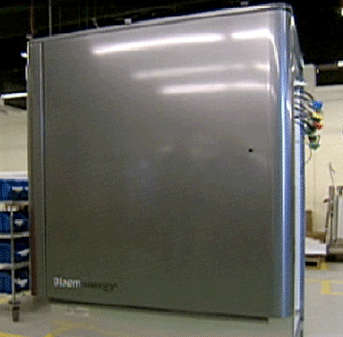Bloom Boxes®
 traditional power grid. Its inventor wants to put one in every home by the year 2020.
traditional power grid. Its inventor wants to put one in every home by the year 2020.The Bloom Box® is the creation of Bloom Energy, a Sunnyvale, California-based company that promises to revolutionize energy with its “power plant in a box.” While essentially a fuel cell – green energy devices that have been around for decades and have yet to compete with even marginal renewable energy sources – Bloom Energy claims to have designed a product that could transform how buildings are powered. A recent 60 Minutes interview with Bloom Energy’s CEO, combined with a handful of high-profile customers, have generated buzz among environmentalists, engineers and builders.
How Do They Work?
The technology for the Bloom Box® comes from an oxygen generator originally designed for NASA's Mars program. When that program was scrapped, the design was converted, with the help of $400 million in funding, into a new type of fuel cell. In Bloom's design, fuel and oxygen are fed to cells (relatively inexpensive, painted ceramic disks) where they combine chemically to create electricity. The cells are separated by a cheap metal alloy, deviating from earlier designs that required precious metals, such as platinum. The cells are stacked into a cube of flexible capabilities; a stack of 64 can power a small business, but an assortment of sizes is fully customizable.
Bloom Boxes® in Service
Bloom Boxes® are still experimental, but 20 Fortune 100 companies in California have purchased the devices at $700,000 to $800,000 each. FedEx, Wal-Mart, eBay and Google have all taken advantage of state and federal subsides by purchasing Bloom Boxes® for use at their headquarters. The primary motive for these companies to embrace green power may be based in public relations, but eBay has boasted that its five boxes have saved the company $100,000 in energy costs.
Benefits of Bloom Boxes®
- flexible fuel sources. While Bloom Boxes® can use traditional fuels such as natural gas, green sources such as bio-gas made from landfill waste, and even solar energy, can also be exploited.
- powerful. Even in its early stages, one Bloom Box® can power one European home, or two to four homes in India. It would take two standard Bloom Boxes® to power the average American home, however. eBay’s Bloom Boxes® (which are powered by bio-gas from landfill waste) generate significantly more electricity than the 3,000 solar panels on the building’s roof.
- inconspicuous. The unit does not vibrate, has no odor, and emits no sound.
- reduced need for traditional power plants, and associated power lines. The box’s creator and Bloom Energy CEO
 , K.R. Sridhar, said in the 60 Minutes interview, “The idea is to one day replace the big power plants and transmission line grids the way the laptop moved in on the desktop and cell phones supplanted landlines.”
, K.R. Sridhar, said in the 60 Minutes interview, “The idea is to one day replace the big power plants and transmission line grids the way the laptop moved in on the desktop and cell phones supplanted landlines.” - consistent and reliable electricity. Solar panels and wind turbines, by contrast, are of little use when clouds or the earth obscures the sun, or when the sporadic wind ceases to blow. In homes and businesses powered by Bloom Boxes®, power outages due to downed power lines or rolling blackouts would be nonexistent.
Concerns
- price. Although Sridhar publicly hopes to reduce the price tag of his boxes to $3,000 within the next decade, skeptics have reason to doubt such optimism. Bloom Energy still has to figure out how to mass-produce the unit and get its costs down low enough to outfit every home with a Bloom Box®. The company has been quiet about the product, leaving skeptics to wonder what makes the Bloom Box® unique from fuel cells made by competing companies who have yet to meet such lofty goals, or even find profitability. Bloom Energy will need to conquer the commercial market, which can afford to utilize larger-scale units, before it can develop affordable residential models.
- need for around-the-clock functionality. Fuel cells must work all the time, as even a minor hiccup could disrupt power to an entire building. At Google headquarters, the units stopped functioning when dust kicked up from a nearby highway and caused the air filters to become clogged. Perhaps power that goes unused can be directed to charge on-site batteries, which can be tapped during power failures.
- carbon footprint. If natural gas is used to power the Bloom Box®, CO2 will be released. Sridhar argues that conventional power plants vent twice as much of this greenhouse gas as Bloom Boxes® do. This comparison must be balanced with the fact that California, where all of the units have thus far been sold, gets much of its energy from renewable energy sources.

